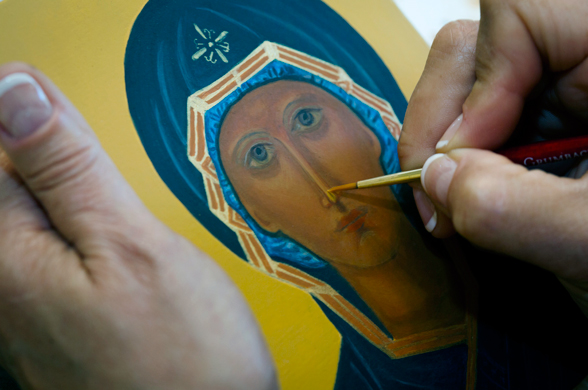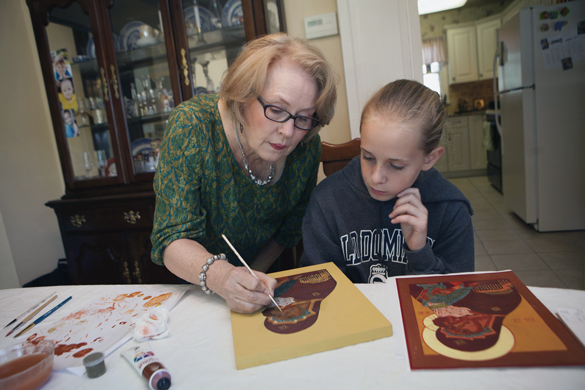by Betty Ellen Walter

ANNANDALE, Va. (CNS) – Veronica “Ronnie” Royal of Virginia has been an iconographer since 1998, working diligently to hone her craft and encourage the use of icons in contemplation and prayer.
Born in Nancy, France, she was raised in the Ukrainian Catholic Church by her Russian mother and Ukranian father. Icons were very much a part of her Church and family life.
She is often commissioned to paint saints who are not particularly popular or are obscure, like St. Andrew Kim Taegon, namesake of a couple’s adopted son. His grandmother commissioned Royal to paint the icon as a gift to her son and daughter-in-law in celebration of their new child, Taegon.
“You have to remember that the church continues to declare saints, and yet iconography originated from the early church,” Royal said. “So there is a place for present-day iconographers to bring Catholic saints to life through this ancient tradition.”
Iconography was a well-developed art form by the third century, but its origins began with the new Church. St. Luke, the apostle and evangelist, painted three icons of Mary, including “Our Mother of Tenderness.”
“The Holy Spirit speaks to us through sacred art and allows us to gain an understanding of the subject’s experiences in the Christian journey that we are all undertaking,” Royal said in an interview.
“St. Damascene calls icons ‘Scripture in paint,’” she continued. “I like that because it suggests the process of visualizing what we know from the Bible or the lives of saints and bringing these experiences to a personal level through prayer.”
The general approach to painting an icon is to begin with a dry, knot-free piece of nonresinous wood and apply coats of gesso, which acts as a special primer. The outline of the icon is put on tracing paper and then powdered with a chalklike substance that can then be transferred to the wood’s surface by tracing each line. Gold leaf is then applied to key places such as the background or a halo, and then the painting begins.
Royal has developed her own approach, which she teaches in her workshop.
Spiritual Awakening
Egg tempera paint is most often used, she said, but she teaches her students with acrylic. “Oils are used sometimes,” she added, “but even the coarsest materials in the hands of a master can become a feast for the eyes and spirit. Whether it is delicate furrows in fabric, the essence of feathers, or each strand of hair, the iconographer brings unique talents and a spiritual awakening to create a venerable image. The Holy Spirit is at work without a doubt.”
Royal has traveled the world to perfect her craft, including a recent visit to Greece to study for a month under an iconographer whose works she admires.
The first image she painted was “Christ the Pantocrator,” and despite how sophisticated her work has become, Royal keeps that original icon close to her heart. “I was so proud of it. I look at it now and recognize the work of a novice.”
As she has honed her craft, Royal said she still often uses the outlines of existing icons. She even examines the works of great masters to see how they depicted saints.
Royal teaches students with varying skill levels during Saturday-morning workshops. Two or three artists often sit at her dining-room table with implements and tubes of paints spread about. At other sessions, there are up to seven iconographers with varying degrees of skill and expertise at work, some of them at the kitchen table.
“I have two students who are exceptional – they could teach me,” she said with a smile.
One of those students, Therese Nakasato of Springfield, Va., isn’t so ready to abandon Royal’s tutelage, noting: “Ronnie has a good eye for detail, and I appreciate what she brings to my icons. I also prefer to work with other artists in order to share ideas and lend support. It’s otherwise a solitary process – certainly there’s a place for being alone while painting. But artists also need each other.”
Royal added, “We all learn from each other, and that is a great blessing.”
Royal’s natural vocation as a teacher and fine focus on detail allow her to bring along new students in the craft while also helping each to realize his or her potential. “I’m demanding, but I don’t ask of any of my students something they can’t do,” she said.
Student Lynn Vecchietti, a sixth-grader who attends parochial school, said that she doesn’t mind being around adults. “We pray, we share our brushes and paints, we work quietly and hard. I really love it and am going to paint St. Michael for my brother John as my next icon.”
Most of all, Royal said, she wants to glorify God and help spread the tradition of iconography.
“As I’ve grown in this vocation, I’ve found that my faith has also grown,” she said. “It’s almost difficult for me to pray without an icon, and I see the virtues of figures I’ve painted in the faces of people that I meet. But mostly, I am humbled by the responsibilities that come with sharing this profound form of worship.”

